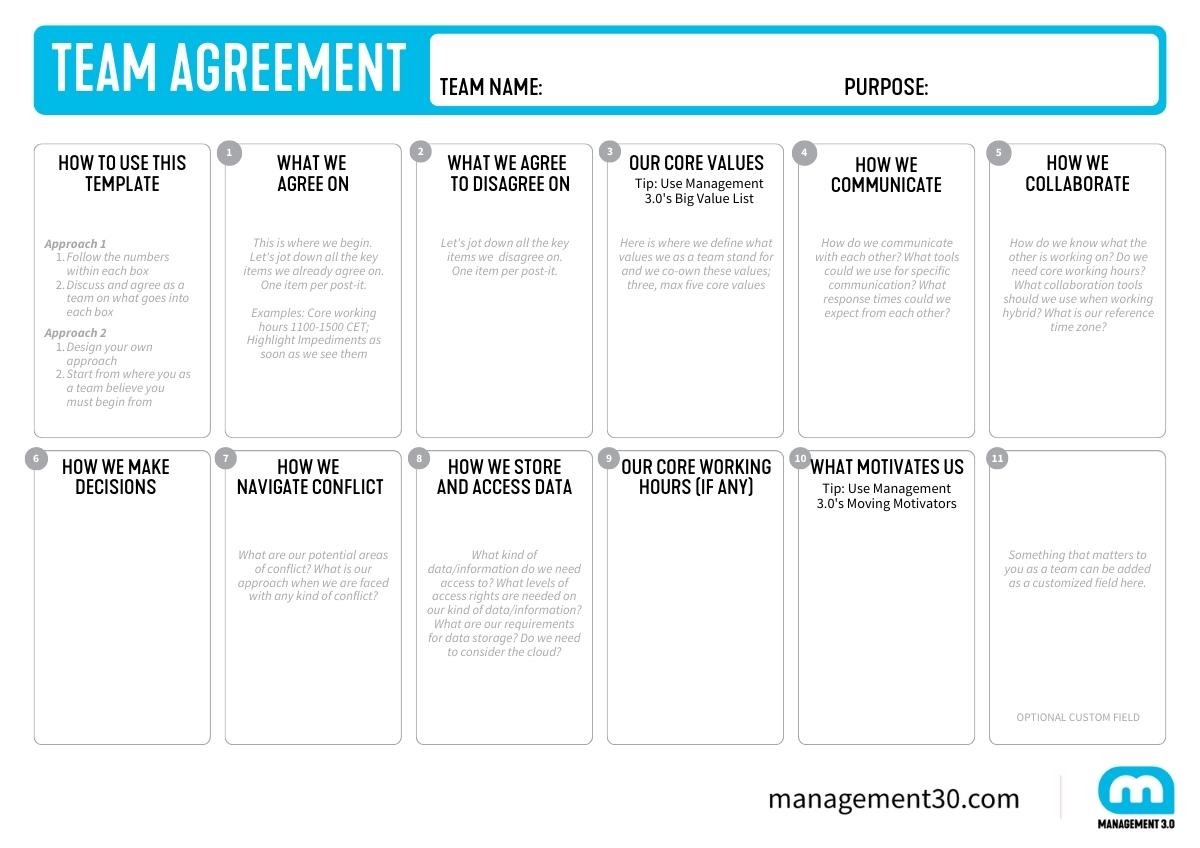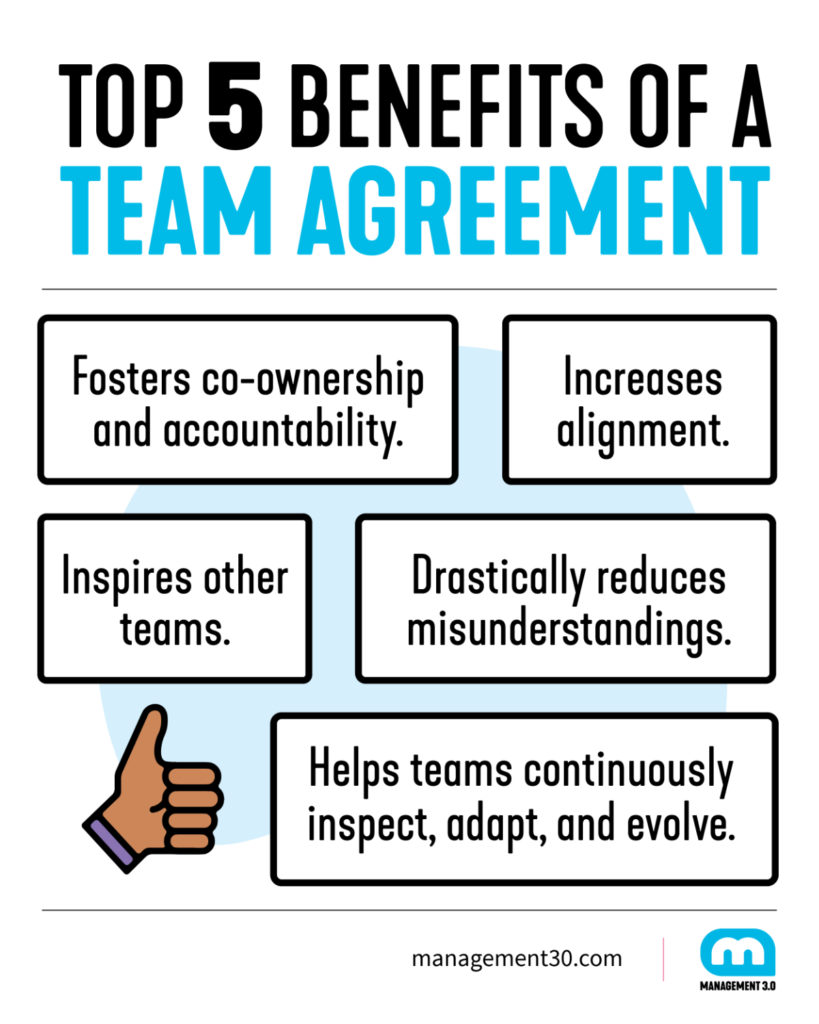What is a team agreement? Why is it important? And how do we create a good one? Sarika Kharbanda, Management 3.0 Facilitator from India, has guided several agile teams through the team agreement creation process and shares her experience.
Download the free Management 3.0 Team Agreement Template
We are all human. This means we have different preferences, expectations, communication tools, and different opinions. There’s bound to be disagreement!
Why Team Agreements?
During one of my many journeys of onboarding teams to a hybrid way of working, I gathered perspectives from the teams and managers.
| Team Perspective Issues | Manager Perspective Issues |
|---|---|
| I work from an area with such poor network coverage. How can I be expected to keep my video on? | His video is always switched off. I have no idea what you are doing. |
| I didn’t work on that task as I had no access to the data! | Team members just grab any task without even informing. |
| If you had told me this was urgent, I would have responded in 1 hour instead of a day! | I’d asked for her feedback about an issue over email. They don’t check email! They can’t expect me to write that again on Slack! |
| Oh! I didn’t know there were core working hours for our team! | Not everyone is reachable during the core working hours! |
| I wasn’t aware whether you were in the office. How could I be expected to keep track of your timezones? | I wasn’t aware whether you were in the office. How could I be expected to keep track of your timezones? |
These issues came as no surprise to me. There’s bound to be misalignment – until we do something about it.
The traditional approach:
- The manager creates a set of rules that the teams must follow.
- The manager calls a meeting and shares the rules to be followed.
- The rules are printed and stuck to team members’ desks.
- The team must now follow the rules.
What happens when such an approach is pushed down the throats of people? For some, it goes well. For many, they get labeled as rule breakers who impede the success of the team.
My approach:
This includes the modern approach to management, whereby a new way of working has to be co-created in the true sense of the word ‘co-creation.’
If we can create an environment where people are invited to contribute and share their perspectives on the issue or problem at hand, they feel they have added value. They feel they have been listened to. When we use their input to co-design the solution for the issue, they feel their inputs mattered and that they’ve added value. They are less likely to resist and more likely to co-own the solution. Isn’t that what we want in the first place?
Why impose a solution when you could get them to co-create it with you and co-own it with you?
How do I co-create?
I work with each team and their respective manager. Each team member, each team, and each manager is unique in their personality, perspectives, and work preferences.
I invest the time to introduce the concept of ‘team agreement’ to everyone.
What is a good Team Agreement?
For me, a good team agreement has always been:
- A basic set of guidelines on how a team collaborates and communicates.
- Guidelines that are created by the whole team’s active contribution.
- A guide to help the team foster a psychologically safe space for themselves.
- A space where the teams outline not just what they agree on but also what they agree to disagree on.
- A space where the teams agree on how they communicate, collaborate, and what values are important to their unique way of working.
- A living set of guidelines that can be revisited and updated as the team continuously learns over a period of time.
- A visual radiator of the team’s way of working and accountability to each other.
Benefits of a Team Agreement
Of the many benefits of creating team agreements, here are a few highlights:
- It brings co-ownership and accountability from each team member
- Drastically reduces misunderstandings
- Increases alignment
- Helps the whole team continuously evolve their way of working by inspecting and adapting
- Inspires other teams
How do teams begin to create their Team Agreements?
Teams soon realize it’s not easy to co-create a team agreement. We are working with people and not robots!
So, it’s best to start with what they know they all agree on.
For one of the teams, agreeing to the core working hours was easy. So, they started with that.
Another team agreed that they did not know each other well enough. So, they would like to start by getting to know each other first. I got them started with the Management 3.0 practice of Personal Maps. With this activity, when they understood Values were crucial for all, they wanted to co-create what their values as a team were.
Another team was beginning from a state of conflict. So, they agreed they would start by enabling resolution to the conflicts that had arisen. I introduced the 360 Degree Feedback Dinner to them. They liked the idea and experimented with that for a few weeks. They even created a separate section within the team agreement for how they would acknowledge and resolve conflicts as a team.
Looking at what some teams had started to radiate visually, other teams got inspired and started to get their manager and team together to create what they called their ‘Team Manifesto’. Each team member signed it and presented it to other teams during the department town hall. They felt so proud of that achievement!

How can you create your Team Agreement? A Team Agreement Co-Creation Workshop
Before the team agreement creation workshop:
- Introduce the concept of team agreement to all participants.
- Identify an independent facilitator.
During the team agreement creation workshop:
- Check-in with an ice-breaker.
- Individual brainstorming.
- Present your responses.
- Questions meant only to deepen understanding of each other’s responses.
- Consolidate and group responses.
- Review final agreement.
- Sign agreement.
You may want to use this team agreement template:

After the team agreement creation workshop:
- Visually radiate the team agreement.
- Refer back to the team agreement whenever a misunderstanding occurs.
- If new team members join your team,
- Introduce them to your team’s way of working using this team agreement,
- Gather their feedback,
- Agree to any required updates as a team,
- Review the updated agreement,
- Sign the agreement,
- Visually radiate the updated team agreement.
- Agree on a regular frequency to revisit your team agreement.

Quotes from the Team Agreement Retrospective
I facilitated a common retrospective across all teams. This is some of what they had to say.
“The team agreement really gave us a bumper start. We stopped making assumptions, finally got to surface and acknowledge, and finally take action on them.”
“We are not completely where we want to be. But, we are happy that we are continuously improving our way of working each day. We have come a long way. We strive to get there together.”
“Us and our manager were completely misaligned on how we work. Simple things caused misunderstanding like when he thought we were slacking off with our videos off, we just had bad network coverage. Surfacing these points and together building trust and actions has helped rebuild our relationship.”
“We’ve all had a different starting point before we got to creating the team agreement. We thought we would just be asked to follow and stick to some template. But the fact is that no two team agreements are alike in any way or form. That this was OK and a done thing! That itself is so cool!”
“Each of our voices mattered. We were all involved in coming up with how we collaborate, how we communicate, where information is stored, how we would resolve conflicts, how we would raise issues, make decisions, etc. It feels great to be part of something WE actually created and then followed with our own will, not something that was forced upon us.”


